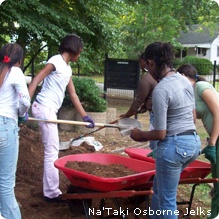We have much more to do and your continued support is needed now more than ever.
Trees, Wildlife and Water – Celebrate National Wildlife Week

Urban areas experience increasing amounts of paving and land development that convert large areas of spongy natural land to hard surfaces that cannot absorb water. When rain hits paved-over or built-over areas, it runs off directly into storm drains and eventually into area streams and rivers. A hard, fast rain, with no vegetation or natural land to slow it down can hit these water bodies with such speed and force that it will result in flooding and severe erosion problems. Downstream areas such as bays and estuaries can get deadly slugs of sediment and chemical pollution from these run-off surges.
Anyone who has stood under a tree at the beginning of a rain shower (not advisable in lighting storms) knows that tree canopy absorbs falling rain. In urban areas this can reduce water run-off by as much as 10 percent and that can make a huge difference in the speed and erosive force of the rain shower. That is one reason trees are increasingly becoming a standard design feature for automobile parking lots which, left uncovered, are huge run-off generators. These same parking lots are also heat on hot summer days and contribute to spikes in temperatures know as “heat islands.” Tree canopy is an effective coolant in these areas and that is likewise good for local wildlife and water.
Trees also need water to grow and can help consume excess water in urban areas. Urban planners and designers are paying more and attention to filling remaining “plantable” spaces in cities and suburbs with trees. The recent trend of planting areas called “rain gardens” in parking lots and other developed areas that are specifically designed to capture rain water and help it percolate into the ground. This absorption is facilitated by tree planting.
Please be sure to visit the original post to read the whole thing, and learn about the ways NWF is partnering with the National Aquarium to protect the Chesapeake Bay and other coastal areas.
![]() Also, celebrate National Wildlife Week by donating to our tree bank today! You can help us reach our goal of planting 75,000 trees this year>>
Also, celebrate National Wildlife Week by donating to our tree bank today! You can help us reach our goal of planting 75,000 trees this year>>





















